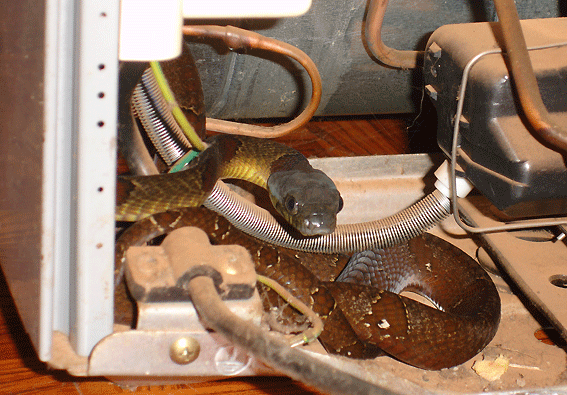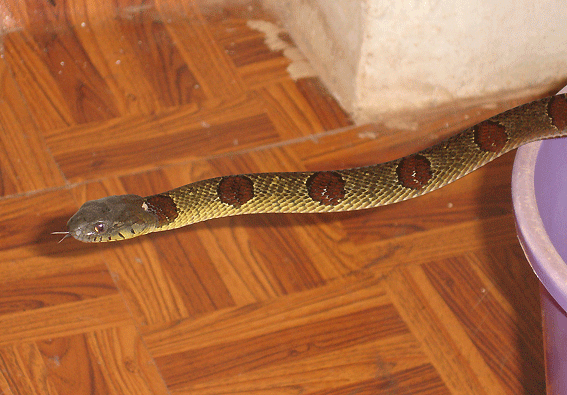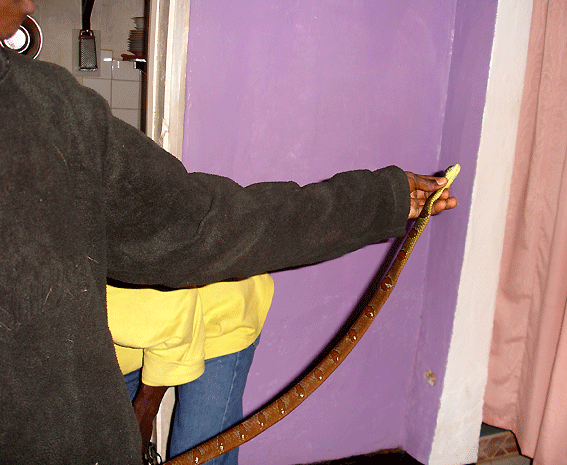Last night was rather exciting because we discovered a snake which had probably lived for a very long time in the back of our refrigerator.
It was a very beautiful animal, no question, but to leave it there was out of question! Once we realized that the snake was almost 2-meters long, there was no way of finding a good night’s sleep with the knowledge that a potentially poisonous snake had the freedom of the house.
Snakes in Uganda are normally killed immediately as soon as they are found. Ugandans (and obviously us expatriates also) fear these creatures and no wonder, since there are many venomous snakes here such as the Green Mamba and Black Mamba. A bite from these snakes in particular can have deadly consequences within a few hours without the antidote.
Without knowledge of snakes, it is obviously also difficult to distinguish between poisonous and non-poisonous snakes. Before seeing our house snake, we thought we had already experienced two Green Mamba snakes, one in our garden here and one in the garden of the first house we lived in at Muyenga. However, with more knowledge since these sightings, both were probably Boomslangs (tree snakes). Still poisonous, but not so deadly as the Mambas.
In the last two instances we had no option but to let our caretaker kill the snakes to prevent them from harming us or indeed perhaps children in neighbouring compounds. We did not know of any other options.
However, this time, fortunately for this snake, last weekend we visited a newly opened reptile centre here in Uganda (www.reptiles.ug; Tel: 0782 – 349583) and we discovered from the workers there that we could call them to come and collect snakes either for releasing into the wild at a later date or for exhibits to add to their growing collection.
With this in mind, as soon as our housemaid raised the alarm, out came the reptile centre’s leaflet and the telephone call was made. At 9pm however, we did not really believe that anyone would come and rescue a snake.
We were told to keep the snake monitored at all times and not to antagonize it until the catchers arrived. After this call, we placed ourselves a safe distance from the snake with a broomstick to hand (just in case!) and watched our snake in the refrigerator. At first, it was just coiled-up, watching us, sometimes poking out its head to see if the coast was clear for a getaway. When this happened, we would tap the broomstick on the ground which scared the snake back into the darkest recesses of the fridge.
After a while this no longer worked and the snake decided to come out (see photo). We then saw just how long it was and deduced that it must have lived in the fridge for some time as it seemed very familiar with its surroundings. It also had a slight saddle in the middle of its body indicating that it must have eaten recently.
Whilst we waited for the catchers to arrive (which seemed like an eternity), my husband surfed the Internet to find information on Ugandan snakes, but unfortunately, this was not much help. We still had no idea if we were dealing with a poisonous variety.
There are hundreds of different web pages on snakes but none of them contains a list with pictures and descriptions of native snakes here in Uganda. I guess it must be a paradise here for a biologist or a snake researcher as one can discover and describe animal species which no human has described before.
We set up boxes in the kitchen doorway hoping that if the snake decided to explore further, it would do so only in its familiar surroundings.
Eventually, two Ugandans arrived via public transport around 10.30pm and my husband went to fetch them from a local landmark using our car.
The rescue operation itself was short and painless despite the fact they had brought no tools whatsoever with them. In order to deduce if the snake was dangerous, they antagonized it and when it tried to slither away, one of the men simply grabbed the snake by the tail and pulled and pulled until the snake let go. It was quickly bundled into a cloth bag, which we provided. We were told that it would have been a different matter entirely if the snake had tried to attack when confronted, for then they would have realized it was venomous. The tip is that a non-venomous snake will always try to get away, but for us their ‘scientific’ explanation sounded like a gamble!
From now on this snake will have a new home in the “Reptile Village” in Entebbe and can be visited there. The men were very interested in it as they had never seen one with such markings and they will now endeavour to find out what species it is. They suggested that it might be a Boiga Blanche, but from looking this one up on the internet, I am not so sure. They did tell us that they had rescued a Pit Viper just four days previously, after it had bitten a worker in a field.
All in all, the service cost us a couple of bottles of beer, 10,000 shillings per man traveling expenses and a 20,000 shilling donation to the Reptile Centre (to look after our snake!). A small price to pay for the reassurance provided.
We learned from our intrepid men that “Mzungus” (whites) are the main people who call the centre when they find snakes. Ugandans unfortunately, are still afraid of all snakes and do not have the understanding that they are worth protecting. There are myths here that snakes can chase humans for kilometers, so every snake is seen as bad and will ultimately be killed if found by most Ugandans.
What can be done about conserving the beautiful array of snakes in Uganda besides all the other problems here, I have not the slightest idea. Possibly there should be a little more education in biology in schools about them, but as I mentioned it is difficult to investigate snakes as there as so many varieties and sometimes the same snake species has a multitude of different colours and markings. Added to this problem is the fact that people learn from village witchdoctors that all snakes are harmful or cursed, making it harder to educate people differently.
And then there are just a handful of people in the whole country who operate on their own initiative. I was told that the Reptile Centre had to seek permission from the Uganda Wildlife Authority before hand-rearing guinea pigs. The baby guinea pigs are then fed to the snakes as the only viable way of keeping them alive (as there is so little money available to keep the centre open). As of yet, there are no development funds available as international donors obviously concentrate on more media effective projects.
Therefore, the reptile centre and its goals will probably remain for a long time on the fringes of society, to be mainly visited by the few `Mzungus‘ who are enticed by the couple of signposts along Entebbe Road. If you find a snake in your house or garden, then I would urge you not to kill it or have it killed, but to somehow help the Ugandans improve their empathy with the creatures they share their homeland with.
Herewith the contact details for the Reptile Centre: it is well worth a visit, even if just to hold huge chameleons in the palm of your hand!
Uganda Reptile Village
Tel 0782 – 349 583 oder 0756 – 250 102
Bunono Village, Entebbe – Wakiso District
PO Box 24, Abayita Ababiri
Email: kazibwe@reptiles.ug or ugandareptilesvillage@yahoo.com
Internet: www.reptiles.ug



